Postcard from Hungary, a guest post by Sarah Copeland
Foraging in The Bakony Mountains of Central Hungary, and an Apple Bread Pudding
There are two things that I consider an exceptional, generous gift. One is a bottle of extra virgin olive oil, the other is a good story.
Today I received the gift of a heartfelt story, and I’m so happy to share it with you. It is also the best way to introduce the fall season here in our newsletter: apples, spontaneous trips to the wild, baking goods, and finding comfort in the kitchen.
Today’s guest is Sarah Copeland. Probably she doesn’t need an introduction, as you might have already encountered her work on-line, among the New York Time recipes, in bookstores, or here on Substack, where she writes EDIBLE LIVING by Sarah Copeland, one of the few newsletters I do not miss an issue, as every story and recipe feels like a precious gift.
She is also the author of Instant family Meals, Every Day is Saturday, Feast and Newlywed Cookbook, and the host of the Food Network Series, Every Day is Saturday, which exemplify Sarah’s standard for gorgeous imagery, luscious recipes, and simple luxuries.
I discovered her writing right here on Substack, and she quickly became one of my favourite food writers. Her writing is honest, refreshing, vivid, evocative. She is generous in sharing stories and recipes, light and shades of her life as a woman, mother, chef, and recipe creator.
The food she shares is the kind of food you crave everyday, food that nourishes and brings sunshine and comfort in your life.
But when I read one of Sarah’s recipes, I am also reminded of the pleasure of cooking and sharing that food. Actually, she is one of those authors you would want to call a friend—I have the same feeling whenever I read Laurie Colwin—someone you would love to spend time with in the kitchen, chopping vegetables, kneading bread, rolling pie dough, and chatting.
One of Sarah’s striking characteristics is the sense of place of her writing.
This is what captured me first, what lured me into her life in Hungary (at that time she was living in Hungary with her family) and then back at home, in a small village north of New York City.
If you want to delve into Sarah’s love letters to Hungary, her husband’s homeland, you can start with some of her latest posts: To Hungary, with Love, which led also to a feature on Food&Wine, For My Family, Hungarian Summers Are As Sweet As Stone Fruit, or and It’s not August without Palacsinta, sweet and nostalgic.
After this brief introduction to her work, you can now understand why I am happy beyond words to share her story and recipe with you all.
And now to you, Sarah.
Long ago, before I had ever visited my husband’s homeland in the Bakony Mountains in Central Hungary–two hours between Vienna and Budapest–I spent September days picking apples at the local apple orchard in Northern Illinois, 45 minutes outside the suburban town where I grew up. My parents had found a family-run orchard out in the country with hay rides, cider donuts, and a country band that played banjos on the stage on weekends. Like many Americans, they made a tradition of taking us to pick apples every fall. We’d eat Macintosh, Jona-golds (my favorites), and Macouns until our stomachs were sour and head home hours later, stuffed on apple pie and hot cider–and the promise of a crisp, shiny apple in our lunchboxes for weeks.
These little treks elicited the most incredible feeling of security and well-being; the orchard was my ultimate happy place. But it wasn’t long before I tasted a different kind of joy–the thrill of finding a fruit tree–whether wild or overgrown from a neighbor's yard, branches dangling from a fenceline, tempting you to taste. Occasionally, I’d forage a nibble of our neighbor’s ripe and juicy plums on late summer days. Later, I took this habit on the road with me: reaching for figs that burst forth from overgrown trees in Greece, wild grapes dangling from fencelines in France, and to New York–where I’d nibble unclaimed mulberries in city parks and cherries in front of brownstones in Brooklyn.
In my late twenties, I met my husband, Andras, as our lives converged in New York City. We’d each already spent the better part of a decade there, living and working – far from home–me across a handful of U.S. states and him across an ocean from his peaceful village life.
On my first visit to Hungary with him, I was smitten by the fruit trees that seemed to dot every landscape. It felt like a mecca for a fruit-lover like me–except the pick-your-own opportunities were not commercialized; they were–well—everywhere. Apple picking happened in everyone’s own backyard–in villages, small cities, and even the suburbs. I wasn’t shy with gleaning basketfuls from his parent's small orchard: cherry and fig in July, plum and quince in late August, and Nyari alma (summer apples) and, later, pears. But I wasn’t sure about the etiquette of the wild plum and apple trees found all over the town parks, in local schoolyards, and outside municipal buildings. In Hungary–especially in the villages–apple trees are commonly planted in front and side yards, which means high yields and fruit that appears to be there for the taking of every passerby.
Over the next 15 years, on summer trips to Hungary together (and later with our young kids, Greta and Matyas), I took to carrying a soft bag or two in the car or on my bike everywhere we went and filling my bag, often rather sheepishly, with any fruit it seemed no one needed or wanted. Year by year, I alternated between asking permission and gingerly grazing, taking one of two lovely bits.
We have learned which trees are fair game: The limby wild apple trees in the Bakony hills we often hike. The tall tree outside the village school, with the firm, tart green apples we can only reach by leaping off the stone wall. The striated, bulbous red apples that line the ditch, hundreds deep, outside of the crumbling old house I once wished was ours. And then there are those we don’t touch, around the newly furbished house on the corner by the village square. Those apples are large, round, and tempting but off-limits, except the few fallen into the soil that need eating before they’re squandered to a gentle rot.
These wild, found, and foraged apples have fueled our annual summer trips, long bike rides, and impromptu hikes that lasted long past dusk. I’ve used them to lure the children along on errands (just a few more minutes) and tucked them into my bag to feed the horses and pigs at a nearby farm where we ride. But I’ve never been brave enough to harvest enough for baking, roasting, or turning into sauce.
In the fall of 2022, Andras and I moved the whole family from our home in upstate New York to his boyhood village in Hungary for part of the year, where we are slowly recovering a small stone house from the rubble of time. There, our children could walk to the village school, speak the language of their ancestors, and have lunch at their Nagymama’s (Grandmother’s) house next door, every day.
As August turned to September, we traded blackberries and plums for apples and pears. We settled into a rhythm: I’d send the children off to school, put on a pot of soup, then sit down to write. At noon, the church bell would ring, and my son would jump the stone fence, grab a green apple (from what was now his school’s apple tree), and race home for lunch with Nagymama, followed by a cuddle with me.
From my large bedroom windows, we’d watch his village friends climb on the town bus en route toward aftercare (the government provides full care for families who need it). Then, he and I would pile into our little Renault and drive to the nearest town, where his big sister went to middle school. With an hour to kill, we’d wander the town square, pick wildflowers that grew out of streams, and stop in the tiny post office with the odds-and-ends collections of children’s toys, chocolates, and tiny books with titles like: erdei gombák–or, Wild Mushrooms). All the while, we’d fill our basket with fallen apples from ditches and sidewalks and any dangling the long limbs of trees outside crumbling, forgotten homes.
We’d stop at the bakery for a Linzer cookie and kakaó (hot cocoa) for him and a coffee for me, then pick up my daughter and head right back home, where I’d set to work peeling, chopping, and baking our spoils. That season, I made jars upon jars of apple sauce, plus French apple tarts, chunky apple cakes, and a little token from home–apple bread pudding. It tasted of everything old and new, of Hungary and my childhood, of all my acquired resourcefulness and the promise of comfort in a world where the language, rules, and etiquette of foraged and fallen fruit was a mystery to me.
When the timer would ring, signaling my latest treat was ready for tasting, I’d splay open the new door (where a window once was) — leading out to hectares upon hectare of forest and field to the smell of the mist falling, the meow of our tiny rescue kitten, the tap of my son’s legs against the wooden steps— a stand-in for the stone steps we’re still saving for — as he ate a bowlful of tender bread pudding.
By dusk, the bells would ring again, signaling nightfall, beckoning us to our beds, satisfied, until it all started again.
RECIPE - APPLE BREAD PUDDING
Recipe by
, creator of Edible Living and author of Every Day is Saturday and the Newlywed CookbookIn Hungary, bread pudding is usually served as a savory dish (as is French Toast), a smart savior for bits and scraps of old table bread–which appears at every meal. I’ve given my own American spin to this, creating the classic warm sweet bread pudding with a mix of both tart and sweeter baking apples. I like to use a mix of leftover bread for this–the variety of textures makes it distinctly feel like authentic peasant food–with some soft bits where the potato bread has soaked in all the custard and some more textured bits from the whole grain bread that often accompanies soup at the noon meal. If you like a tender, french-toast texture for your bread pudding, use only challah or brioche.
Yield: 6 to 8 servings
BREAD PUDDING:
2 tablespoons unsalted butter plus soft butter for the dish
1 to 2 tart, firm green apples such as Crispin, Ginger gold or Granny Smith
1 firm, ripe baking apples, such as Empire, Cortland, Jonagold
½ large loaf of leftover bread, such as potato bread, challah, brioche, peasant bread or a mix (see cook’s note), cut into 2-inch cubes (about 5 to 6 cups)
2 cups whole milk
1 cup half-n-half
4 eggs, beaten
⅓ cup unbleached sugar
2 teaspoons pure vanilla extract
Pinch sea salt
TOPPING:
1 tablespoon unbleached sugar
1 teaspoon ground cinnamon
Butter a 2.5-quart casserole dish with soft butter. Peel and core the apples, then cut into thin strips or small cubes, about ½ inch each. Layer the bread cubes and apples into the prepared dish.
Whisk together the milk, half-n-half, eggs, sugar, vanilla, and salt, adding spices in if desired (see cook’s note below). Pour over the bread mixture press down, and set aside for the bread to soak in the milk mixture for about 1 hour.
Preheat the oven to 350 degrees. Sprinkle the top with the cinnamon sugar. Bake until the custard is set but still quivering and the edges of bread have gotten toasty and browned, about 30 to 40 minutes. Serve warm or at room temperature.
COOK’S NOTES:
Adding up to ¼ teaspoon of ground ginger or cardamom or both will amp up the fall-spice feel of this bread pudding but isn’t required. More flavorful apples will impart a lot of flavor, but if you’re using basic supermarket apples, add the spices in.






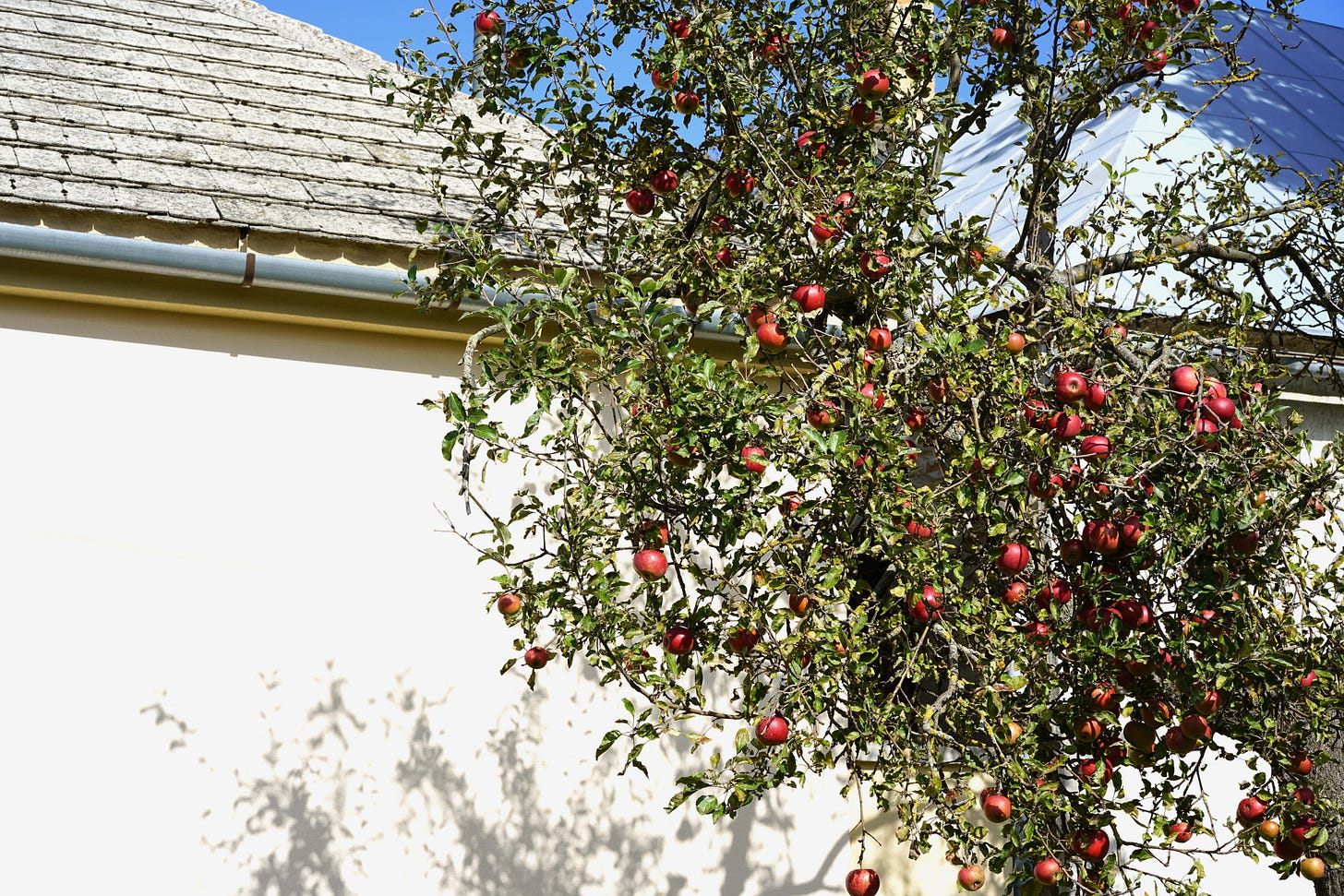
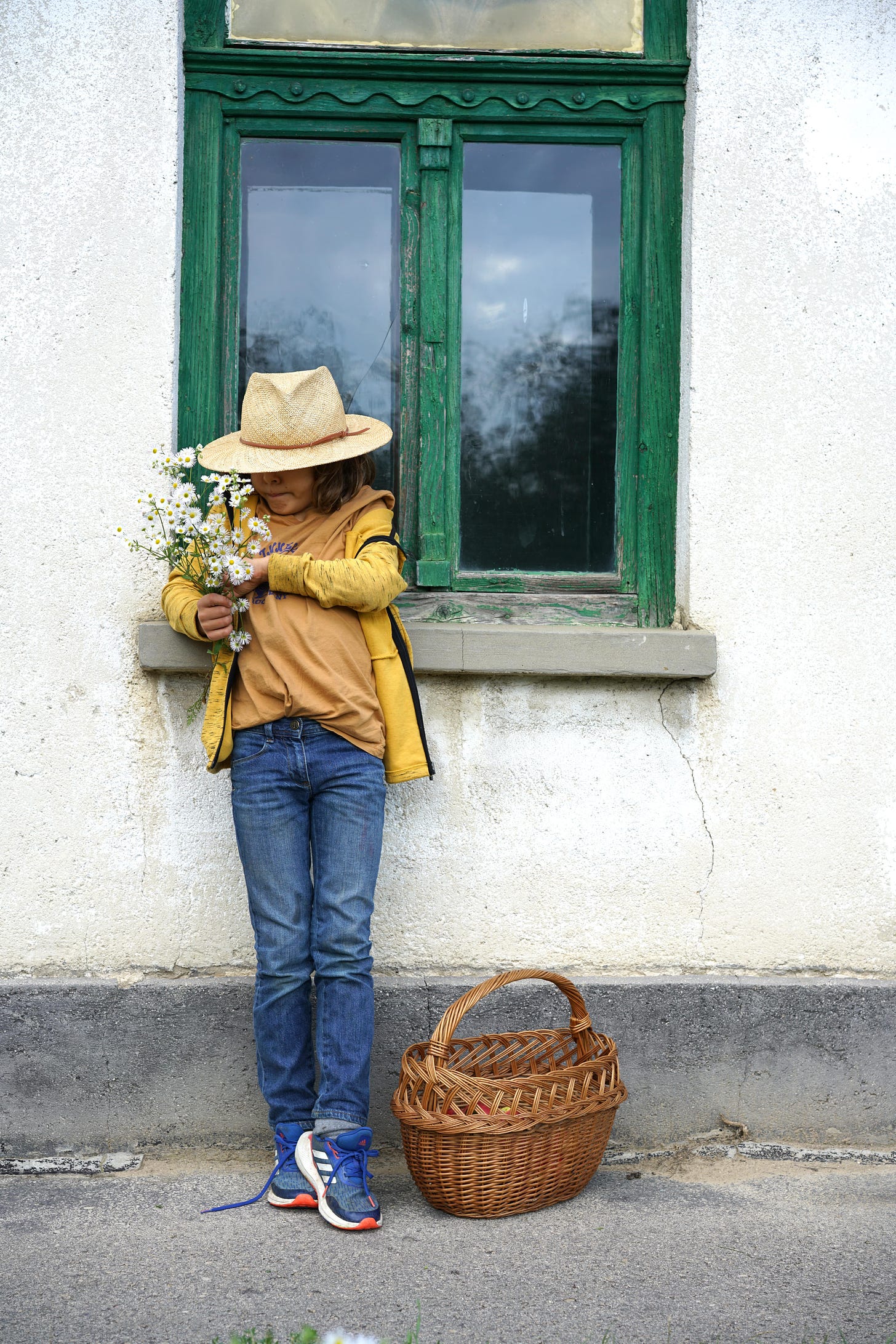
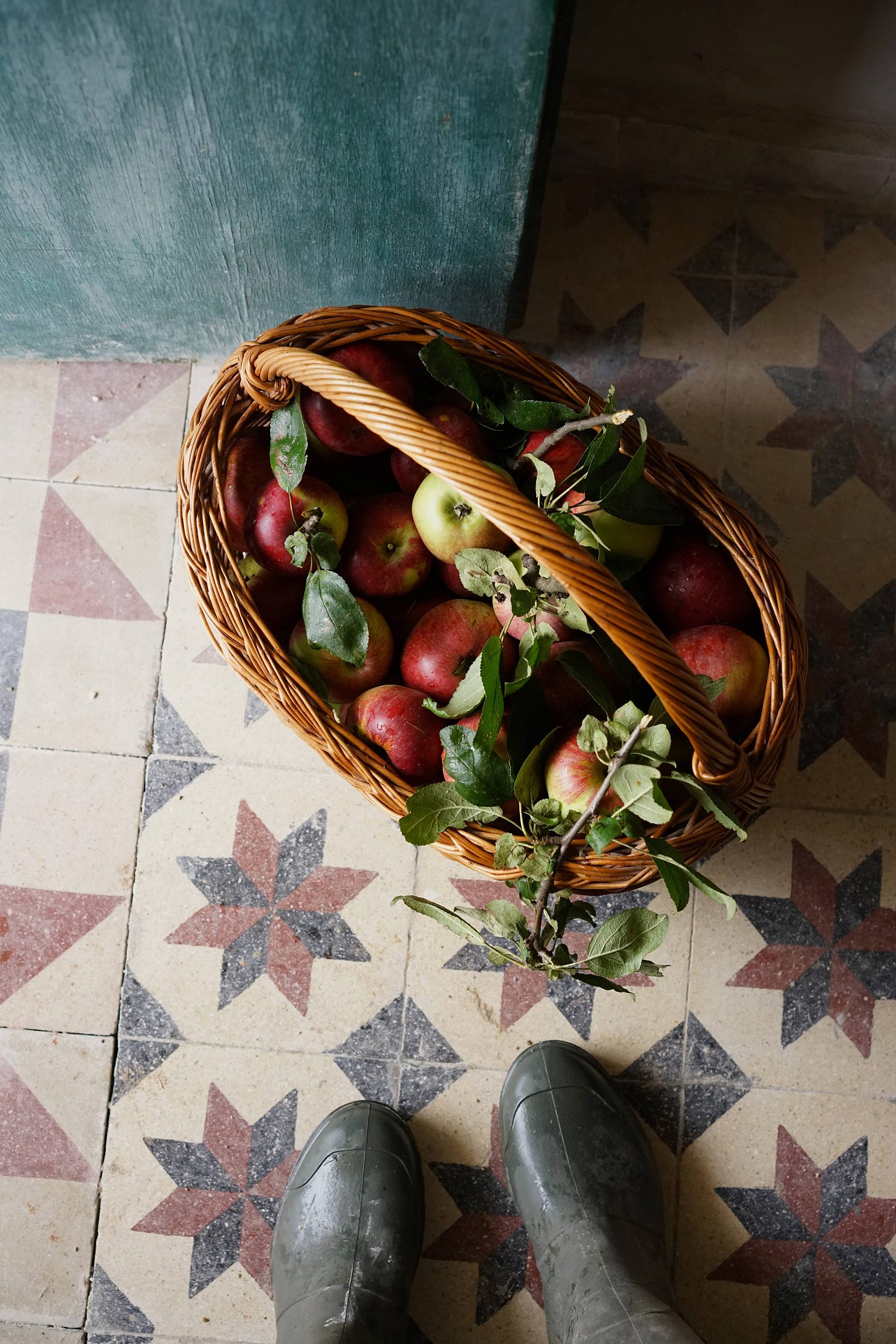
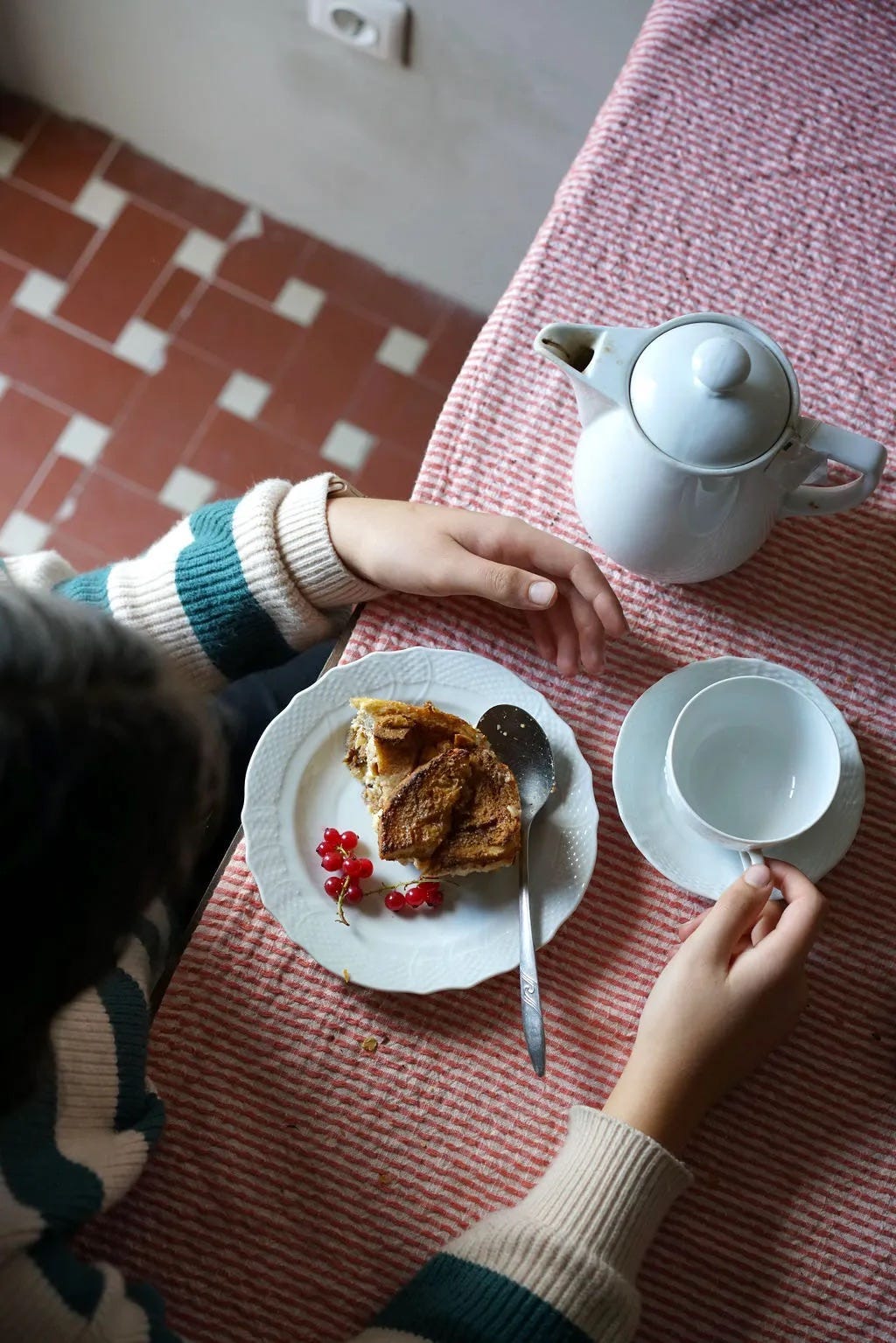
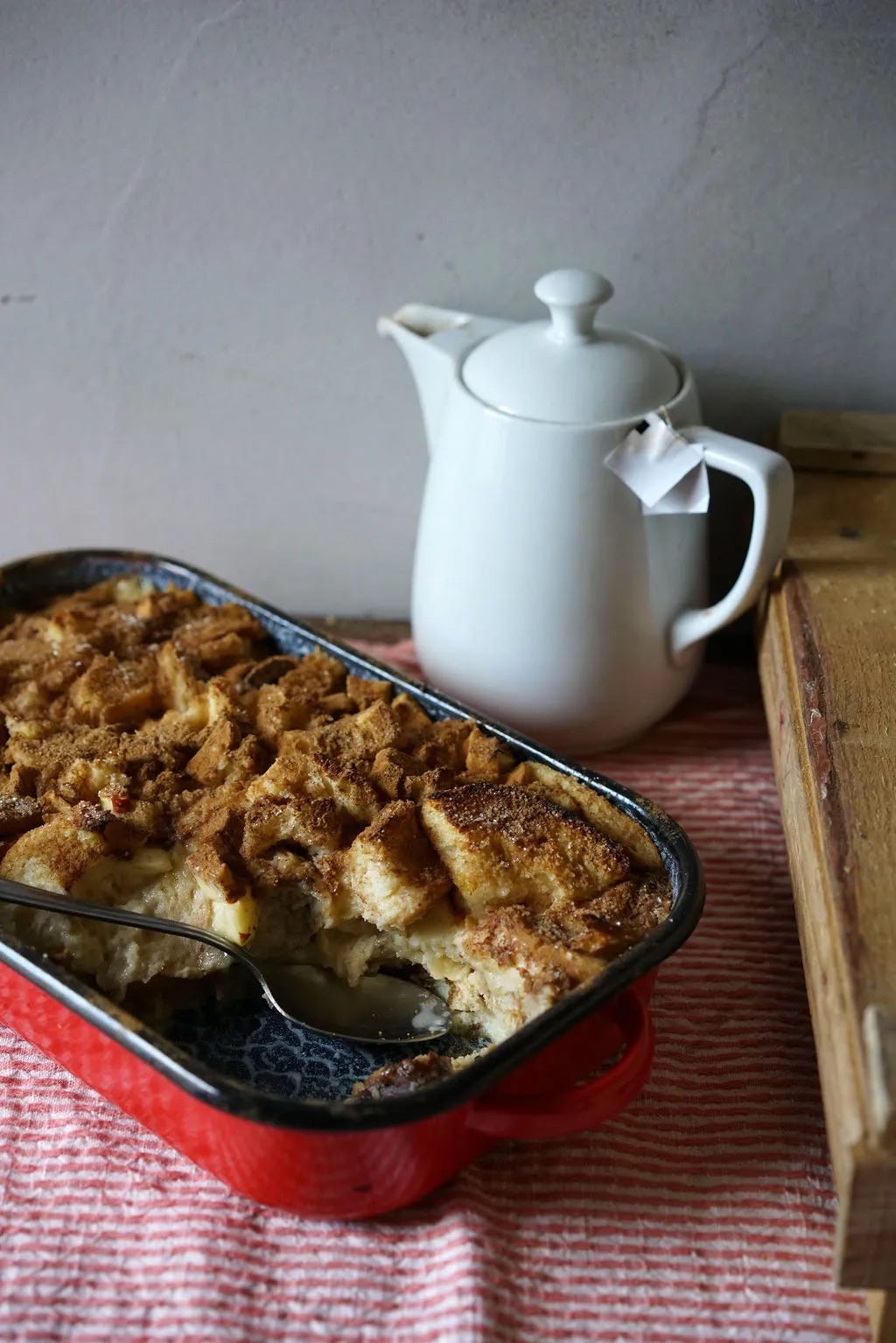
What an honor to get to know each other, our families and our worlds via our writing. It's a true gift to be seen and heard and understood by another writer, and you--Guilia--have been such a gift to me via my time on Substack. I'm so grateful! Thank you for sharing this. x
Love that photo with the untied shoelaces, and apple bread pudding, delicious!!